Holidays are not complete without a Christmas tree. Being the most wonderful season of the year, people keep themselves busy preparing different Christmas decorations that can add beauty to the tree. Unfortunately, some unseen bug species are also busy enjoying the tree even before you bring it inside your house.
The common Christmas tree bugs in North America are adelgids, aphids, bark beetles, pine needle scales, pine sawflies, praying mantises, psocids, and spiders. Most of them are very tiny and go unnoticed. Some have similar behaviors and are present in certain trees only.
Trees are among the common habitat of bugs. This is why it’s not surprising to also see them in Christmas trees. But before taking any action, you should know how to identify them correctly. In this article, you will learn some facts about bugs that are commonly found in Christmas trees and how to get rid of them safely.
Table of Contents
Are Bugs Common in Christmas Trees?
Bugs are not common in Christmas trees. In fact, it is believed that only one out of 100,000 trees has them. But still, it does not necessarily mean that your wonderful Christmas tree is safe from them. Most of them are very small and can hardly be seen by the naked eye. Hence, these bugs can annoy your holidays.
Where Do Bugs Like to Hang Out in Christmas Trees?
Generally speaking, bugs in Christmas trees love to hang out in branches and other woolly parts of the tree. But since they are almost microscopic, you may not see them one by one, especially the eggs. Most of these species are only noticed once the eggs hatch into nymphs or larvae. Adult bugs are a rare sight, though.
Common Christmas Tree Bugs
1. Adelgids
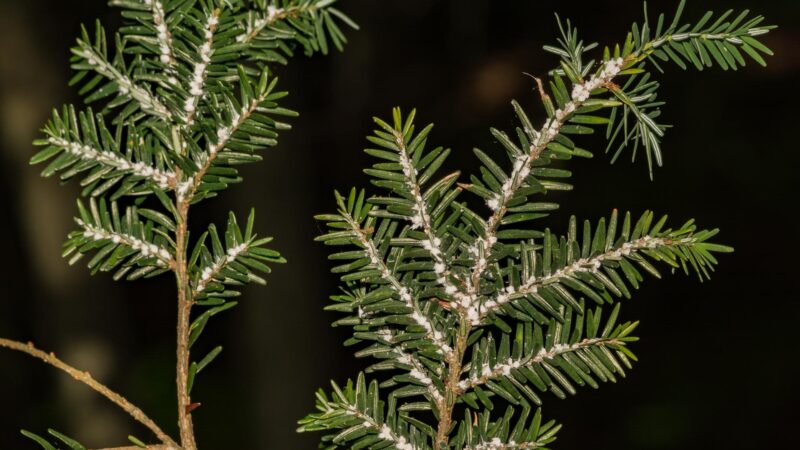
General Information
Adelgids are insects in the order Homoptera and are also true bugs. Among the common adelgid species found in North America are the balsam woolly adelgid (Adelges piceae), Cooley spruce gall adelgids (Adelges cooleyi), pine bark adelgid (Pineus strobi), and hemlock woolly adelgid (Adelges tsugae).
Appearance
Adelgids look like aphids and are closely related to Phylloxeran aphids (Phylloxeridae) and woolly aphids (Eriosomatidae). They have oval, soft-bodied insects. Some species have wings, while some are wingless. These tiny insects produce white, waxy filaments that destroy trees but are harmless to humans.
But unlike aphids, adelgids have no tail-like cauda, which is a protrusion above their anus. They also have very short or no abdominal appendages. Also called pine aphids, these true bugs are usually black, but some species are pink or purple. Their eggs are mostly red and are also covered with wool-like material.
Size
Adult female adelgids are around 1/32 inches (0.8 mm) long, while nymphs are less than 0.5 mm long. They are very difficult to find on trees unless there are tons of them. Females lay egg sacs that contain around 25 eggs each. Hence, adelgids are only recognized in colonies due to their white, fluffy, woolly masses.
Lifespan
There are no records stating the average lifespan of adelgids. However, they produce two all-female generations a year, which usually overlap in the spring. Some wingless adelgids can have five generations annually. Nymphs undergo at least six developmental stages. Females usually die after depositing their eggs.
Habitat
Just like most bugs in Christmas trees, adelgids are also plant-specific. Balsam woolly adelgids are usually found in balsam fir and Fraser fir trees. Pine bark adelgids live in pine trees. Hemlock woolly adelgids live in Hemlock trees, which are not suitable for Christmas trees since they lose needles right after being cut.
Diet
Adelgids feed on sap at the bases of needles of their host plant. Most adelgid species attack both old and new trees, although healthy trees can somehow tolerate them. Hemlock woolly adelgids are dormant and will stop feeding from July to October, while balsam woolly adelgids are present from April to October.
Threat
The two most common predators of hemlock woolly adelgids are the laricobius beetle (Laricobius nigrinus) and the Japanese lady beetle (Sasajiscymnus tsugae). Some beetle and fly species have been introduced to prey on balsam woolly adelgids. However, they only had a little effect on population control.
2. Aphids
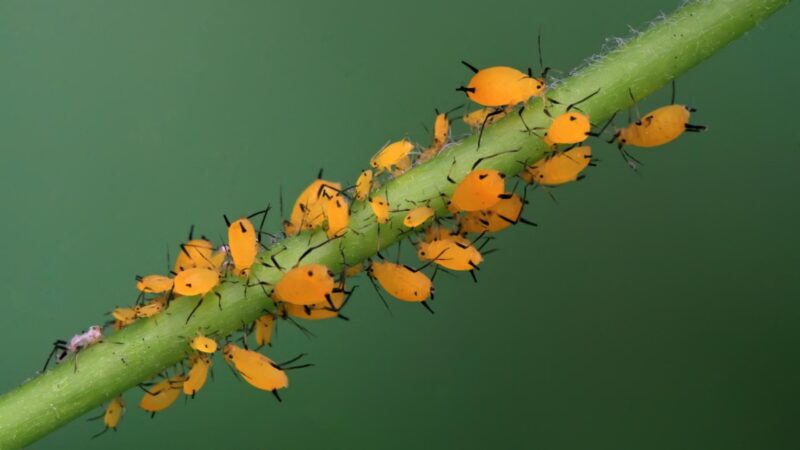
General Information
Scientifically known as Aphidoidea, aphids are members of the subphylum Hexapoda. Common names include ant cows, blackflies, greenflies, plant lice, and whiteflies. The aphids that specialize in conifers (such as cypress and pine trees) are the giant conifer aphids, which are in the genus Cinara.
Appearance
Conifer aphids have piercing-sucking mouthparts and six long legs. As mentioned above, these sap-sucking insects resemble adelgids but have cauda. Younger generations are wingless, but the newer ones have wings. Cinara aphids can have black, brown, or gray bodies. Nymphs look like adults but smaller.
Size
Cinara aphids are about 1/8 inch (3.2 mm) long. Also referred to as white pine aphids, giant conifer aphids are among the largest aphid species native to North America, hence the name. But due to their small sizes, they are nearly invisible to the naked eye. In Christmas trees, you will often see them in groups.
Lifespan
Generally speaking, aphids have an average lifespan of only 1 month. They can have up to 20 generations a year, depending on the species.
Habitat
Aphids that are found on Christmas trees are host-specific, which means that species live on specific plants only, depending on their names. For instance, white pine aphids are only found in white pine trees. But in general, aphids live in barks, twigs, developing stems, unopened flower buds, and the underside of leaves.
Diet
All aphid species are herbivores, which means that they eat plant material. They suck sap from plants, causing poor plant growth. The damages caused by aphid feeding include dead shoots, stunted twigs, twisted and curly leaves, and yellow leaves. Some aphids produce honeydew that causes sooty mold on plants.
Threat
The most common predators of aphids are lady beetles or ladybugs. Among the other aphid-eating insects are lacewings, soldier beetles, and syrphid fly larvae. But because aphids reproduce very quickly, their predator insects may not be able to eliminate them completely. Some non-toxic insecticides also kill aphids.
3. Bark Beetles
General Information
Scientifically known as Scolytinae, bark beetles rarely attack healthy and well-established trees. Instead, they prefer those severely stressed or dying to the earlier circumstances such as disease. These beetle species are typically present in Christmas trees even before they are harvested, but not in lumber.
Appearance
Depending on the species, bark beetles can be black, brown, or dark red. This beetle species has a cylindrical, hard body, elbowed antennae, and very strong mandibles. When viewed from above, their head is partly or hidden. Bark beetle larvae are grublike, off-white, and have a robust body and a brown head.
Size
Bark beetles are approximately 1/8 inch long and look like a coffee bean or match head. There are over 600 bark beetle species in the United States. This includes the pine engraver beetle (Ips pini) and the red turpentine beetles (Dendroctonus valens). They are 6-10 mm (1/4-3/8 inch) long and are the largest of them all.
Lifespan
There are no documents stating the average lifespan of bark beetles, but their life cycle is usually completed in a year. Some species may spend two years completing their life cycle, depending on the food source.
Habitat
Bark beetles usually live and breed in dying trees or trees that are under stress. They can also be found in firewood that was cut from recently-dead trees. Most of them are host specific, which means that they live in one kind of tree only or in trees that are related to their host tree. Females lay multiple eggs under the bark.
Diet
As the name implies, bark beetles eat tree bark, especially those used as Christmas trees. Their larvae dig tiny holes in the trunk and feed primarily under the bark tissue. Despite being one of the most destructive forest pests in the world, they don’t eat dry wood. Furniture and healthy trees are safe from them.
Threat
Among the natural predators of bark beetles are birds such as woodpeckers. Some parasitic wasps, insects, and other beetle species also eat bark beetles. Nevertheless, they only cause a minor effect in controlling these beetles. Fortunately, most bark beetles die due to food shortages and cold weather.
4. Pine Needle Scales
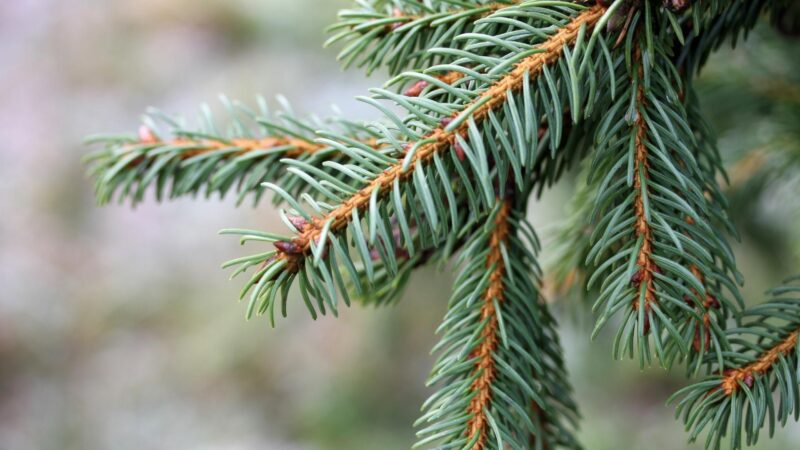
General Information
Scientifically known as Chionaspis pinifoliae, the pine needle scale is the most common scale insect on Christmas trees. Fortunately, not all species reproduce indoors since they overwinter as immatures. This includes the pine tortoise scale (Toumeyella parvicornis) and the striped pine scale (Toumeyella pini).
Appearance
Pine needle scales have flattened red-orange bodies with some tan portions at one end and yellow at the apex. These armored insects produce a white, oyster-shell-shaped, waxy cover. Adult female scale insects don’t develop wings and legs, while males have wings but don’t fly that far and are rarely seen.
Size
Adult pine needle scales are about 1/16-1/8 inch (2.5-3.0 mm) long and are usually unnoticeable because they don’t move. On the other hand, crawlers are very small but do move. Developing males are smaller than developing females, though. These females will later secrete a covering that is around 1/3 inches long.
Lifespan
There are no records stating the average lifespan of pine needle scales. But to give you an idea, young female scales undergo two molting stages, which usually last for about 5 weeks. Young males only molt once, which lasts for 2 weeks. Adult females usually retain needles for 3 years before they drop to the ground.
Habitat
Pine needle scales live in ornamental shrubs and backyard trees that are usually used for Christmas trees. They overwinter in April as eggs. These eggs hitchhike in trees before they are brought home for the holiday season. Eggs hatch in a few weeks, and the nymphs will start to crawl on floors near the Christmas tree.
Diet
Adult females pine needle scales, and their young suck sap from needles or twigs with their hairlike mouthparts, while adult males don’t feed at all. These sap-sucking pests feed on the needles of most species of fir, spruce, pines, and spruce. Infested trees will have a yellowish appearance until they become silver.
Threat
The most common natural predator of pine needle scales is the minute lady beetle (Coccidophilus atronitens). This beetle species have the same annual life cycle of the scales. Some parasitic wasps also kill scales but are not enough to control a huge infestation. Nonetheless, extremely cold weather can kill them.
5. Pine Sawflies
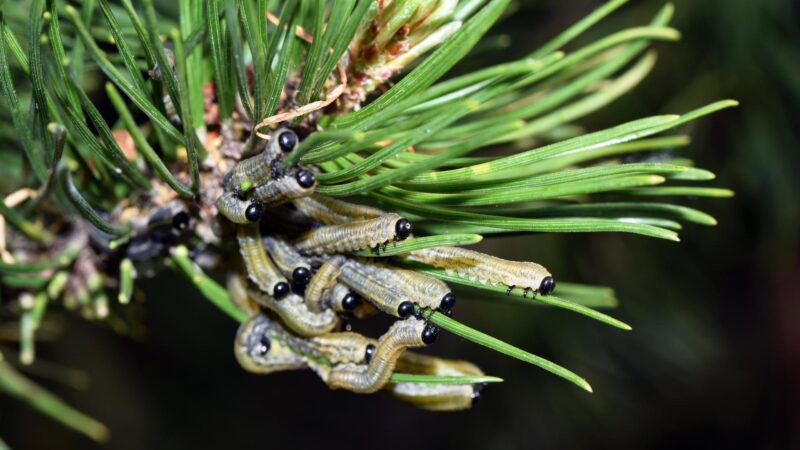
General Information
Contrary to what some people think, the pine sawfly is not a fly species. Instead, this insect is in the order of Hymenoptera, which includes ants and wasps. Among the pine sawfly species found in North America are the European pine sawfly (Neodiprion sertifer) and Introduced Pine Sawfly (Diprion similis).
Appearance
Adult pine sawflies look like large bees and have thick-waisted bodies. Both sexes possess slender, feathery antennae, along with four transparent to light brown wings. However, females have a sawlike ovipositor which they use for cutting slits on plants where they lay eggs. These eggs are typically white or yellow.
Size
Pine sawfly eggs are about 0.5 mm wide, while larvae can grow up to 18-25 mm (3/4-1 inches) long, depending on the species. They will later form cocoons that are 3-6 mm wide and 7-10 mm long or as big as gelatin pill capsules. Adult females are 8-10 mm (5/16- /8 inches) long and tend to be bigger than males.
Lifespan
Adult pine sawflies have an average life span of only 7–9 days. Meanwhile, the entire life cycle is completed within 1-2 years. Eggs hatch within 2-8 weeks, but larvae can live for more than a year as they undergo various developmental stages. This is why most pine sawfly species only have one generation per year.
Habitat
Adult pine sawflies live in trees, but not for long. As mentioned earlier, they have a very short lifespan. Their larvae mostly live at the edge of living pine needles. Each species has its host plant, depending on its name. As plant-specific pests, they spend their entire lives on the same tree until they become adults.
Diet
Pine sawfly larvae eat old or new (or both) needles of various types of pines, depending on the species. For instance, larvae of European pine sawflies feed only on the outside of old growth, while larvae of introduced pine sawflies eat both old and current growth. Adults don’t eat and die shortly after laying eggs.
Threat
The natural predators of adult pine sawflies and larvae are ants, birds, frogs, lizards, and rodents. Their eggs are the diet of fantails and honeyeaters, while pupae are eaten by some species of beetle larvae. But for heavy sawfly infestations, new trees can be treated with some insecticidal soap or by wiping them out.
6. Praying Mantises
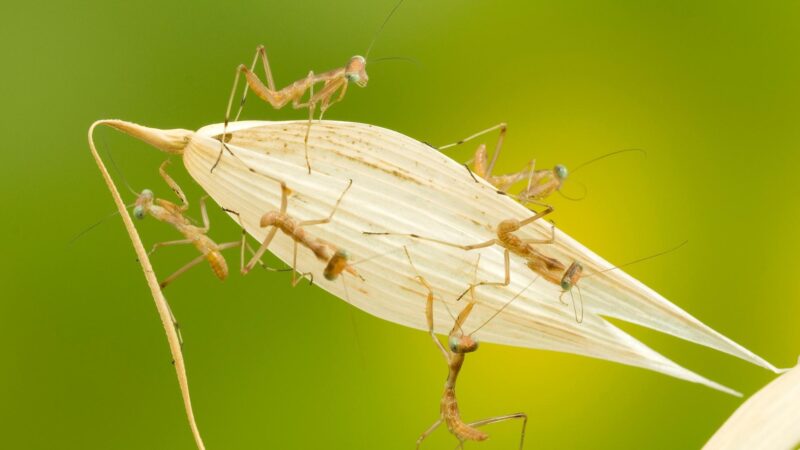
General Information
Scientifically known as Mantis religiosa, the praying mantis has some interesting characteristics. While hunting for food, they fold their raptorial front legs as if they are praying, hence their name. Praying mantises can also change their color, depending on their background. This makes them invisible to prey and predators.
Appearance
The praying mantis has a very unique look. These forelegs have long, sharp spines that they use for grabbing prey. They also have a triangular head, compound eyes, and a long thorax. Praying mantises are either green or brown, depending on where they are. They can also turn their heads 180 degrees.
Size
The size of a praying mantis depends on its species. The European Mantis (Mantis religiosa) is 50-60 mm (2-2.4 inches) long, while the Carolina mantis (Stagmomantis Carolina) is 47-60 mm long. The Chinese mantis (Tenodera sinensis) is about 5 inches long and is the largest mantis species in the US.
Lifespan
The lifespan of praying mantises depends on the species, gender, environment, and food availability. Female mantises live for 8-12 months and will naturally die within 2 weeks after they lay eggs. On the other hand, males have an average lifespan of 7-20 months. Smaller mantis species live shorter than the big ones.
Habitat
There are more than 1,800 praying mantis species spread around the world, including Africa, Asia, South America, and some parts of North America. Praying mantises live in various habitats but will thrive best in temperate regions. They can be found in the tropical rainforest, deserts, grasslands, and meadowlands.
Diet
Praying mantises are carnivores and feed on live spiders and insects, such as crickets, and grasshoppers, as well as frogs and mice. If food is scarce, they may eat each other. This cannibalism behavior usually occurs during and after mating. But contrary to common belief, not all females eat the head of their male mates.
Threat
The natural predators of praying mantises include bats, birds, lizards, snakes, and spiders. But contrary to rumors, it is not illegal to kill a praying mantis. This ridiculous rumor started to spread in the 1950s. During those years, killing an insect that appears to be kneeling and praying is thought of as inhumane and immoral.
Related: What Does Praying Mantis Eat? | Information and Facts
7. Psocids
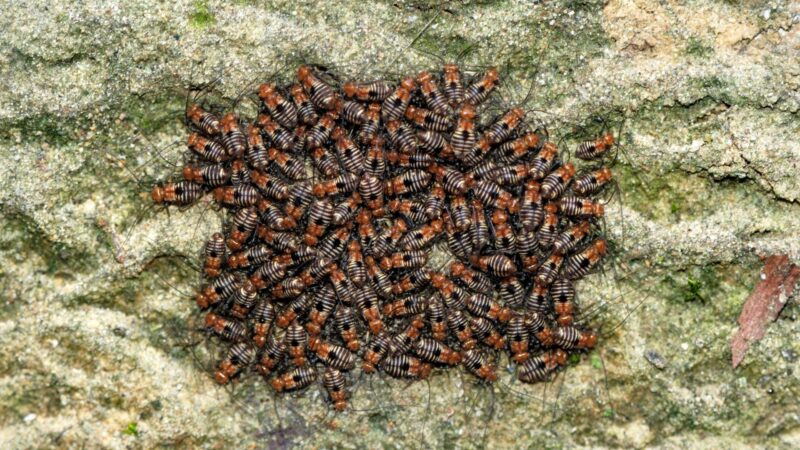
General Information
Scientifically known as Psocoptera, psocids are not lice and don’t bite as lice do. Also known as bark lice or booklice, these non-parasitic insects can be present in Christmas trees. But then, they can also occur in packaged food products. Nevertheless, they are not harmful to plants and are only nuisances.
Appearance
Psocids are usually brown or gray, with long antennae and a broad plate (or nose) at the front of their heads called clypeus. This protuberance cannot be seen by the naked eye. They also have soft bodies and six short legs, and some adults have four transparent wings. Some species are wingless, though.
Size
Adult psocids are less than 3/16 inches (4.8 mm) long, while young nymphs are around 1 mm long. During their lifetime, females lay 50-100 eggs which are approx. one-third their size. Unlike most bugs that are found in Christmas trees, psocids don’t produce a white, waxy cover. Hence, a huge presence can easily be noticed.
Lifespan
Eggs hatch into wingless nymphs within 2-4 weeks, and there are usually 2 generations per year. The average lifespan of psocids is 6 months, and their life cycle is completed in 2-3 months. Nymphs undergo 3-8 nymphal stages, which last for about 2 months, depending on the temperature and food availability.
Habitat
Psocids live mostly in the leaves, trunk, and branches of various kinds of trees, including those used as Christmas trees. Some species occasionally live in houses, buildings, and food facilities, and breed in stored food products. They prefer warm, damp environments, making them very visible during summer.
Diet
Psocids eat decaying plant matter, such as leaves, paper, pollen, fungi, and mold. They also feed on insect fragments, dead insects, grains, and even glue from bookbindings. Despite being scavengers, psocids don’t destroy trees. However, they reduce food quality and contaminate stored food products with their feces.
Threat
There are no known predators of psocids, but some parasitic wasps on trees can eat them. Indoors, the best way to kill psocids is to reduce humidity by using a dehumidifier. You can also use sticky traps.
8. Spiders
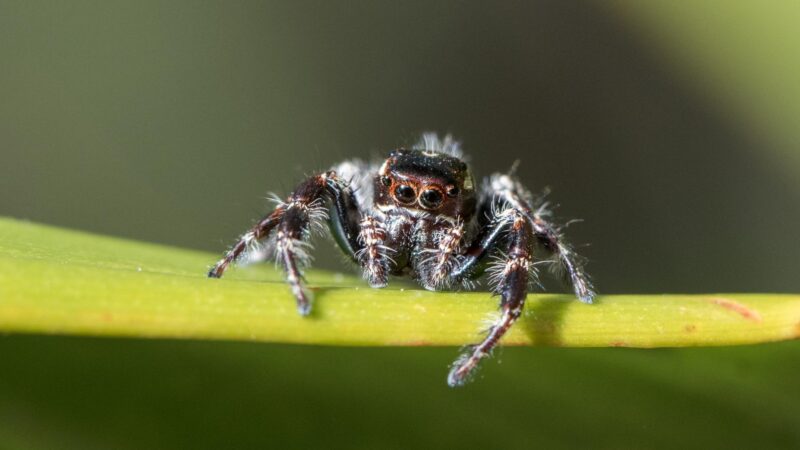
General Information
Spiders are not insects but rather are arachnids. Spiders in Christmas trees could be of any species. Although they look scary and some are venomous, some European countries consider finding a spider web in Christmas trees as good luck. Indoor spiders are mostly harmless and are only nuisances.
Appearance
Unlike insects, spiders have eight legs instead of six. These eight-legged creatures also have eight eyes and two body parts. They are the abdomen and the cephalothorax, which are composed of the fused head and the thorax. Spiders have dense, microscopic hair on their body and legs that helps them in several activities.
Size
The size of spiders that can be seen on Christmas trees depends on the species. Nonetheless, their body length varies from 0.5 mm to 90 mm (0.02 to 3.5 inches). Tarantulas can reach up to 3 inches. Spiderlings or baby spiders are about 1.6 mm (1/16 inch) long and are hardly noticeable unless they are in huge numbers.
Lifespan
According to the Guinness World Records, a female Gaius villosus, known as “Number 16” from Australia, holds the record of being the world’s oldest spider. This particular trapdoor spider has lived for at least 43 years. But then, the lifespan of spiders depends on the species. They can live for 2-25 years or more.
Habitat
There are more than 3,000 spider species in North America and live everywhere. This includes trees, deserts, backyards, and indoors. Spiders that are found on Christmas trees could be spiderlings after eggs hatch during warm temperatures or adults that became active after overwintering. They may leave soon, though.
Diet
Spiders are considered carnivores and eat small insects such as flies, moths, and mosquitoes. Sometimes, they also eat spiders. Basically, spiders will eat anything that is trapped in their webs. Some spider species, such as Zebra jumping spiders and wolf spiders, don’t spin webs. Instead, they chase their prey.
Threat
Among the natural predators of spiders are centipedes, mud daubers, scorpions, and spider wasps. Birds, frogs, lizards, and toads also eat spiders. Tarantula hawks, which are a type of huge spider wasp, feed on tarantulas aside from plant nectar. Some spider species, such as Thailand Zebra Leg tarantula, are edible.
Should You Worry if You Find Bugs in Your Christmas Tree?
There’s nothing to worry about finding bugs in your Christmas tree. This is because most of them don’t cause severe damage to your tree. They also don’t bite or sting humans and don’t carry diseases. These unexpected houseguests may also leave soon to find a suitable place for them. Otherwise, they will die.
Can I Spray Christmas Tree With Bug Spray?
You should never use bug sprays on your Christmas tree. Spraying insecticides (especially aerosol sprays) indoors is very dangerous. It can cause fire and even death. Note that these products are flammable, as well as your Christmas tree. Christmas lights and plastic decorations around it can also easily get burned.
How to Get Rid of Christmas Tree Bugs Safely?
Eliminating Christmas tree bugs is not as difficult as you think. As mentioned earlier, these pests are not harmful to humans, and you don’t have to use bug sprays. All of them, except for psocids, are not considered destructive pests but rather nuisances. Here are some safe ways to get rid of bugs in Christmas trees:
- Don’t smash them, or they will leave some stain. Instead, use any kind of vacuum cleaner and throw the contents of the vacuum bag in your outdoor trash can.
- Instead of bug sprays, use insecticidal soap
- Neem oil, is an effective indoor plant spray. Be careful since it can slightly irritate your eyes and skin.
- Food-grade Diatomaceous Earth (DE) also kills bugs but is not toxic to plants. But be careful because inhaling large amounts can cause nasal irritation, and direct contact can lead to eye and skin irritation. Wearing a mask is highly recommended. Like neem oil, positive results are not immediate.
- Since Christmas tree bugs are harmless, you can also pick up the visible ones. To help you see them better, use a flashlight.
- For heavy infestations, you may replace your Christmas tree or call a professional pest control service.
How to Prevent Christmas Tree Bugs?
The biggest challenge with Christmas tree bugs is that they are mostly seen if there is an infestation. They are also very likely to hitchhike in trees while they are still eggs, which are more difficult to see. So, before bringing your Christmas tree to your home, here are some tips to help prevent bugs from hitchhiking:
- Inspect the tree thoroughly, especially the branches and leaves. If you find some egg masses, nymphs, or any bug, you can simply remove them by hand.
- Shake the tree vigorously. Some farms have mechanical tree shakers to do the job for you.
- Wash the tree with water using a garden hose and dry it under direct sunlight. Most bugs don’t survive extreme heat.
As mentioned above, seeing bugs on your Christmas tree is not a major concern. You can still enjoy your holidays despite their presence. Getting rid of them also does not cost much. But still, you should control them at once before they can lead to severe infestation. Otherwise, you will need a new Christmas tree.
List of Sources
Common Insect Pests of Christmas Trees
Cinara Aphids on Christmas Trees in North Carolina